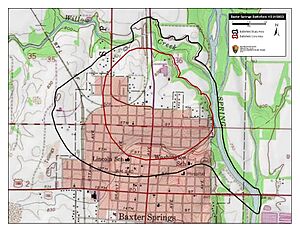Battle of Baxter Springs facts for kids
Quick facts for kids Battle of Baxter Springs |
|||||||
|---|---|---|---|---|---|---|---|
| Part of the Trans-Mississippi Theater of the American Civil War |
|||||||
|
|||||||
| Belligerents | |||||||
| Commanders and leaders | |||||||
| Strength | |||||||
| 400 mounted guerrillas | 96 infantry 200 cavalry 1 mountain howitzer |
||||||
| Casualties and losses | |||||||
| 2 killed, 2 wounded | 103 soldiers killed, 18 wounded, 10 civilians killed | ||||||
The Battle of Baxter Springs, also known as the Baxter Springs Massacre, was a small but important fight during the American Civil War. It happened on October 6, 1863, near what is now Baxter Springs, Kansas. This battle involved a group of pro-Confederate fighters called bushwhackers, led by William Quantrill, and Union soldiers.
In late 1863, Quantrill's Raiders, a group of about 400 armed men, were traveling south through Kansas. They were heading to Texas for the winter. Along the way, they captured and killed two Union supply drivers who had come from a small army post called Fort Baxter. The bushwhackers then tried to attack the fort but were pushed back. After that, they moved to the nearby prairie and attacked another group of Union soldiers, leaving very few survivors.
Contents
The Fight at Fort Baxter
Quantrill decided to attack Fort Baxter. He split his men into two groups. One group, led by David Poole, went down the Texas Road. There, they met Union soldiers, many of whom were African Americans. Poole's men chased and attacked the Union troops. Some soldiers were killed before they could reach the fort, which was made of earth and logs.
The fort was defended by about 25 cavalry (soldiers on horseback) and 65-70 infantry (soldiers on foot), including United States Colored Troops. Poole's group attacked the fort, but the soldiers inside fought them off bravely.
A Hero's Stand: James Pond
First Lieutenant James Burton Pond was a hero during the defense of Fort Baxter. He later received the Medal of Honor, which is the highest award for bravery in the U.S. military.
His award recognized his "extraordinary heroism." He was in charge of two cavalry companies when they were suddenly attacked by many more enemy fighters. Lieutenant Pond bravely gathered his men and, after a tough fight, pushed the enemy away from the fort. Then, he went outside the fort by himself and fired a howitzer (a type of cannon) three times. This confused the enemy and made them leave.
The American flag kept flying over the fort thanks to the brave actions of the 2nd Kansas Colored Infantry. They helped keep the Union soldiers fighting.
Attack on Blunt's Column
After leaving the fort, Quantrill's main group moved onto the open prairie. There, they unexpectedly ran into a Union group escorting Maj. Gen. James G. Blunt. General Blunt was moving his headquarters from Fort Scott, Kansas to Fort Smith, Arkansas. Quantrill's men had many more fighters than the Union group.
Quantrill's men were wearing Union uniforms, which tricked General Blunt's soldiers. They were taken by surprise. Quantrill's group killed most of the Union soldiers, even many who tried to surrender. Among those killed were a military band, Maj. Henry Z. Curtis (who was the son of another general), and Johnny Fry, the first official westbound rider of the Pony Express. In total, 103 soldiers died. An artist and reporter named James R. O'Neill was also killed.
A few men managed to escape to Fort Baxter. Soldiers from the fort then went out to look for survivors. There were very few, but General Blunt was one of them.
After this terrible attack, Quantrill sent a message to Lieutenant Pond, demanding that he surrender the fort. Pond refused. Quantrill's second-in-command, William T. Anderson, wanted to attack the fort again. But Quantrill said no, and his fighters left for Texas.
What Happened Next
General Blunt was removed from his command because he failed to protect his soldiers. However, he was soon put back in charge. Union supporters called the killings a "massacre" because so many were killed, even those trying to surrender. This conflict was typical of the very harsh fighting that happened along the Kansas-Missouri border during the war.
Fort Baxter was made stronger for a short time. But by the end of 1863, the Union Army moved its troops back to Fort Scott, which was a better-protected fort. Before leaving Fort Baxter, Union forces destroyed it. They took anything useful so the enemy couldn't use it.
Quantrill and Anderson continued to disagree about how to fight. In 1864, they split their forces, which meant the bushwhackers mostly fought only in Missouri.
Later, Baxter Springs became the first "cow town" in Kansas. It was a stop for cattle drives heading to markets and railroads further north. By 1875, about 5,000 people lived there.


